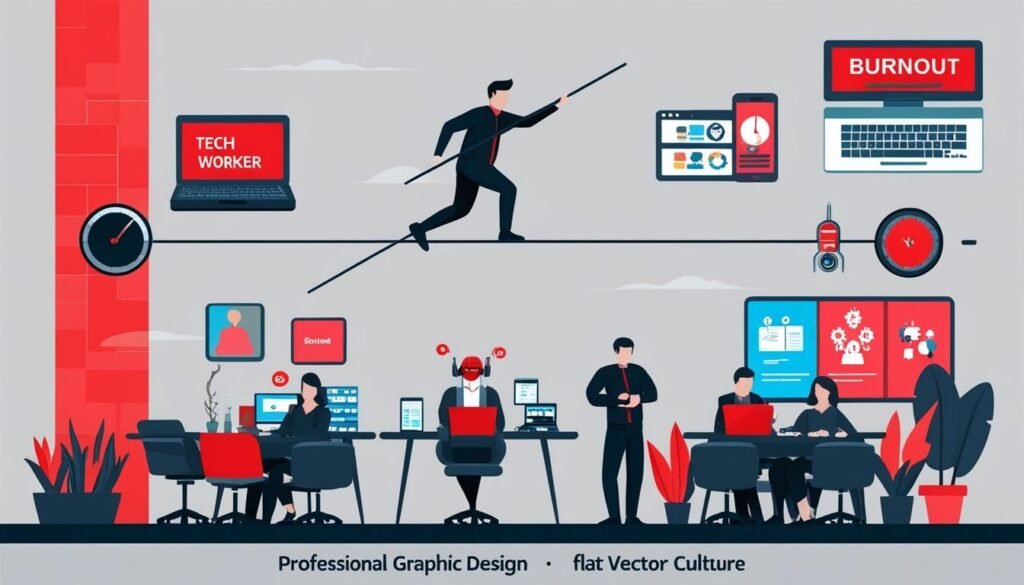The rising pressure in the information technology sector is leading to increased burnout, but experts suggest strategies like automation and flexible working could provide relief.
Burnout within the information technology sector has emerged as a pressing concern, particularly in high-pressure roles such as DevOps, cloud migrations, and software development. The demands of adhering to tight deadlines, maintaining constant system uptime, and addressing critical technical challenges can create an atmosphere rife with prolonged stress. This environment not only hampers productivity but also escalates turnover rates among employees. However, the implementation of strategies prioritising balance and efficiency is seen as a viable means to mitigate these challenges.
Venkata Soma, a renowned thought leader in the industry whose publications include “Leveraging AI and ML to Enhance DevOps Practices and Automate Cloud Operations” and “Challenges for Implementing DevOps in Legacy Systems”, has taken a proactive stance against burnout in the technical domain. Having managed cloud infrastructure for a Major League Baseball team, Soma successfully achieved a 15% reduction in costs through optimisation and a 25% faster deployment rate by automating Continuous Integration/Continuous Deployment (CI/CD) processes. He notes, “These tools help in minimising manual intervention, thereby reducing burnout.” By leveraging advancements in automation technologies like Kubernetes and Infrastructure as Code (IaC), organizations can create scalable systems that enhance both efficiency and employee well-being.
As IT roles often involve extended working hours, Soma highlights the importance of encouraging clear boundaries between professional and personal time. Flexible working hours and remote work options could serve as effective methods to alleviate stress experienced by employees. The establishment of policies supporting flexible schedules would ensure that team members feel less overwhelmed, particularly during peak project seasons.
“Fostering a supportive workplace culture is equally important,” Soma remarks. Research indicates that employees who feel appreciated and supported are significantly less likely to experience burnout. Thus, it is essential for managers to cultivate an environment characterised by open communication, enabling staff to discuss workloads and challenges without fear of repercussions. Regular check-ins and constructive feedback are pivotal in strengthening team dynamics and fostering a sense of belonging and empathy. Furthermore, prioritising mental health through employee assistance programs, counselling services, and routine wellness check-ins can significantly contribute to a healthier workforce.
The uneven distribution of work also plays a critical role in contributing to burnout. Overloading specific individuals with tasks can lead to exhaustion across the board. To combat this, Soma suggests that responsibilities should be evenly delegated and tasks rotated among team members, keeping work engaging. Utilizing task management tools can assist in monitoring workloads and ensuring that no employee is overwhelmed.
Investments in professional development opportunities are essential to keeping employees engaged and motivated. Offering training, certifications, and career advancement programs not only fosters a continuous learning environment but also helps professionals acquire new skills, thereby mitigating feelings of stagnation. Streamlining workflows and automating repetitive tasks further reduces stress levels among IT staff.
In summary, industry leaders such as Venkata Soma play a crucial role in driving automation and optimizing system scalability. These technological advancements are set to alleviate some of the pressures faced by IT professionals, contributing to a more balanced work environment. The trajectory of the IT landscape indicates an increasing reliance on serverless architectures and AI-enhanced practices, aimed at boosting efficiency while simultaneously diminishing stress levels among employees.
Source: Noah Wire Services
- https://www.businesswire.com/news/home/20241119272259/en/New-DHR-Global-Report-Reveals-Burnout-Having-Little-Impact-On-Employee-Engagement – Corroborates the high levels of burnout among employees despite high engagement, and highlights the impact of workloads and job insecurity on burnout.
- https://www.cio.com/article/657960/burnout-an-it-epidemic-in-the-making.html – Supports the widespread problem of burnout in the IT industry, including the effects of increased workloads, employer demands, and the impact on different generations of workers.
- https://www.rackwareinc.com/the-role-of-devops-in-successful-cloud-migration – Explains the role of DevOps in cloud migration and recovery, including the use of automation, CI/CD, and Infrastructure as Code (IaC) to reduce manual intervention and enhance efficiency.
- https://jfrog.com/devops-tools/article/cloud-migration/ – Discusses the benefits and challenges of cloud migration, including the need for automation and efficient processes to mitigate burnout and improve productivity.
- https://www.businesswire.com/news/home/20241119272259/en/New-DHR-Global-Report-Reveals-Burnout-Having-Little-Impact-On-Employee-Engagement – Highlights the importance of professional development opportunities in increasing employee engagement and reducing feelings of burnout.
- https://www.cio.com/article/657960/burnout-an-it-epidemic-in-the-making.html – Supports the need for flexible working hours and remote work options to alleviate stress and burnout among IT employees.
- https://www.rackwareinc.com/the-role-of-devops-in-successful-cloud-migration – Emphasizes the importance of fostering a supportive workplace culture through open communication and regular check-ins to reduce burnout.
- https://jfrog.com/devops-tools/article/cloud-migration/ – Discusses the importance of task management and workload distribution to prevent overloading specific individuals and reduce burnout.
- https://www.businesswire.com/news/home/20241119272259/en/New-DHR-Global-Report-Reveals-Burnout-Having-Little-Impact-On-Employee-Engagement – Corroborates the need for prioritizing mental health through employee assistance programs and wellness check-ins to mitigate burnout.
- https://www.cio.com/article/657960/burnout-an-it-epidemic-in-the-making.html – Highlights the impact of uneven work distribution and the importance of rotating tasks to keep work engaging and prevent burnout.
- https://www.rackwareinc.com/the-role-of-devops-in-successful-cloud-migration – Supports the use of technological advancements like serverless architectures and AI-enhanced practices to boost efficiency and reduce stress levels among employees.
















